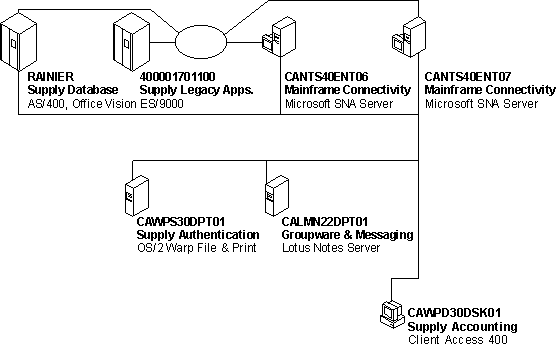
The Supply and Manufacturing division is responsible for the manufacturing of the signature terra cotta pots and other standard economy pots, as necessary. The division is also responsible for distributing the pots to the retail stores, based on stock and special orders placed by those stores.
The manufacturing plant was essentially an IBM shop when Terra Flora purchased it. The sale included the ES/9000, which was running various business-operations software. These software applications did not communicate with each other. The pot manufacturer had purchased an IBM AS/400 and had begun working on a plan to customize and migrate business operations from the ES/9000 to the AS/400.
Upon closer analysis, it was discovered that due to the specialized applications running on the ES/9000, such as the sophisticated money-exchange rate application, migration was not cost-effective. At that time, software was implemented on both servers to allow transfer of necessary information on a fixed schedule between the two machines.

Figure 4.3 Supply and Manufacturing Division network diagram before company-wide consolidation
The ES/9000 is running Virtual Machine/Enterprise Systems Architecture (VM/ESA). All the division's accounting applications and the sophisticated money exchange application run on the ES/9000.
The AS/400 is currently running V2R3 operating system; the databases for business operations are written in a combination of DB2 and RPG/400. The AS/400 runs applications including inventory management and control, a distribution-scheduling system, a production system, and the order system for raw materials for the production of the terra cotta pots and other lines of product.
The business processes at the Supply and Manufacturing division are described below. Each process is numbered, and the process flow is documented using numbers and arrows on the network diagram.
1. The Supply and Manufacturing division receives product orders from their customers (the retail stores and distribution centers) by phone or fax.
2. An employee inputs the orders on a Warp client through a front-end application to a DB2 product-ordering database on the AS/400.
3. Exchange-rate information is automatically posted to the accounting database on the ES/9000.
4. A product order summary is printed, and the production manager schedules the production of pots for the day, based on the product orders received.
5. The production staff makes the scheduled product.
6. The daily production is entered into the production DB2 database on the AS/400.
7. The daily production is automatically posted to the accounting database on the ES/9000.
8. The production system on the AS/400 generates recommended stock orders, based on the raw materials used for the day's production. The orders are printed for the plant manager to review and, upon approval, are faxed to the suppliers of raw materials.
9. The production system updates the DB2 retail-store-customer ordering system. This updates on-hand inventory and then automatically recommends filling the outstanding product orders from the retail stores and distribution centers, based on production and the date on which the orders were submitted.
10. The retail-store-customer ordering system automatically sends appropriate accounting information to the accounting database on the ES/9000.
11. The retail-store-customer ordering system updates the DB2 distribution database about which orders are to be filled.
12. The distribution system prints product pick tickets, shipping labels, and necessary customs papers.